The Soybean Trust: Local Soybeans Connecting Cities and Agricultural Communities
Lately, Japanese food has been coming back under the global spotlight—as the formula for Japanese longevity and for its health benefits. One of the mainstays of Japanese cookery are soybeans, being the ingredient for basic Japanese foods ranging from tofu, boiled beans, and natto to soy sauce and miso, two vital condiments. But these days, Japanese food is not as Japanese as it would seem; only around five percent (on a calorie basis) of the soybeans consumed in the country are domestically produced.
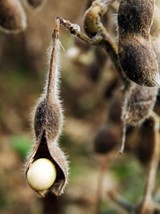
It is not certain when soybeans were brought to Japan from China, but it is known that their cultivation had begun in Japan no later than 1,300 years ago. Kojiki (Records of Ancient Matters), a compilation of Japanese mythology dating to the eighth century, makes mention of five grains: rice, wheat, adzuki bean, millet, and soybean.
There are a few areas in Japan, such as Iwate and Gifu prefectures, where the custom still survives of making misodama , balls of boiled and mashed soybeans from which miso are produced. Prior to World War II, many farming households across Japan made miso from homegrown soybeans. Soybeans were typically planted along the paths between fields until the 1960s, when intensive single-crop agriculture became the norm. The farmers knew that bean plants can fix nitrogen in the soil and alleviate the effects of continuous cropping.
Today's low production levels can be attributed to the rations of soybeans from the United States that supported the Japanese people's diet in the immediate postwar period. Tofu shops across Japan, which are said to have numbered 50,000 at the time, greatly relied on the American soybeans. These shops also provided employment to many repatriates from the former Japanese colonies. The problem with the imports was that they were actually grown for oil production and did not taste very good, but over the years the United States, as well as China, came to produce better-tasting soybeans.
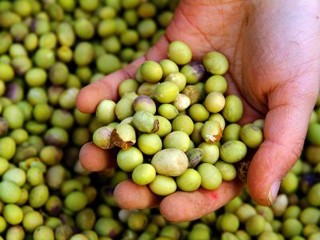
Another major issue has emerged in recent years, however: genetic modification. The production volume of genetically modified soybeans has grown at tremendous speed since they were first approved in the United States in 1994. Today the United States is the largest producer of soybeans, which were first introduced to the country when Commodore Matthew Perry brought them home from Japan. More than 40 percent of the soybeans produced worldwide are from the United States, where GM variations account for over 80 percent of the soybean acreage. Its top importer is Japan.
But no long-term studies have proven the safety of GM soy, and there are concerns about the large burden it imposes on the ecosystem, as well as its potential health effects. And yet, in Japan, the issue has never been debated in the Diet. Moreover, foods using soybeans with a GM content of five percent or less can be labeled "not genetically modified."
Citizens alarmed by this situation have launched a variety of campaign groups opposing GM foods. Another expanding movement is the soybean trust. Placing top priority on increasing domestic production of soybeans, these "trusts" aim to support domestic soybean producers and grow soybeans with their own hands.
One such movement is the Daizu Revolution, which calls on youths living in the Tokyo metropolitan area to grow their own soybeans and connects these youths with soy farms near the capital. The project has been conducted for four years by the nonprofit organization Toziba.
Farms Seeking Youthful Energy, Youths Seeking an Agricultural Lifestyle
There are said to be some 300 local varieties of soybeans of diverse colors, shapes, and flavors across Japan. But until a few years ago, the only domestic soybeans used at tofu shops were improved varieties, such as Fukuyutaka from Kyushu and Enrei from the Tohoku region. The local varieties, preserved on a small scale in their native areas, were on the verge of disappearing, pushed aside by trading houses and major wholesalers busy with speculative trading. These rare beans are now coming back into demand for their rich flavor and aroma.
The idea behind the Daizu Revolution project is to grow local varieties of soybeans for the participants' own consumption. Though the project had a small start in 2004, the membership has now grown to 200. The members, mainly young city dwellers, make trips to the farms year-round for planting, weeding, harvesting, threshing, and miso making.
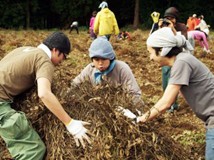
All of the partner farms are within commutable distance to the Tokyo metropolitan area. I accompanied a trip to one of these, the Miyamotoyama soy field, in Chiba Prefecture. The owner, Minoru Saito, is the thirty-third heir to a farm in a lush agricultural village in a largely urbanized area. The family lives in a 200-year-old house.
On the day of my visit, 70 percent of the roughly 30 participants were young women. They hailed from various walks of life: securities company employee, IT worker, cook, part-timer at a movie theater, and so forth.
The soy they were growing in the 10-acre field was a fragrant and savory local variety called the Koito Zairai. This was the day for harvesting, a two-hour task if done with 50 people. While some of the stalks took only one hand to pull out, most were a hassle to extract from the damp soil, even with both hands. The uprooted stalks were bound with string while pressing down with the knees, then piled high in the middle of the field for drying, with groups of four people packing them hard.
A month later, on an icy day in mid-January, the members gathered again for threshing. As the dried stalks were run through the thresher—after snapping the sturdy stems so as not to jam the machine—green-tinted beans came falling into a bag. Those that split and scattered about were also gathered up, except the worm-eaten ones, which were left there for the birds.
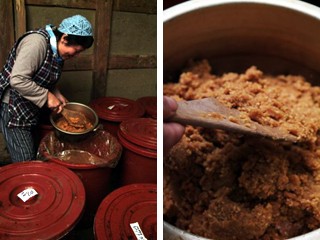
The final event of the annual cycle, I was told, would be miso making with the soybeans the members grew and harvested. Many miso tubs lined the Saito family's ancient miso storehouse.
"It helps to have extra hands for harvesting," Saito says. But in fact, the amount of work for the family is too considerable to strictly regard the participants as "helping hands." Still, Saito casts a compassionate eye on the youths who flock to his farm. What with the widening gap between the rich and poor, he says, the working conditions for Japanese youths are worse today than in the days when farmers spent part of the year away from home for seasonal jobs.
For Toziba representative Takashi Watanabe, too, the project is not just about supporting farms. Watanabe wanted to do something for young urbanites, who feel a vague unease about the furor over foodstuffs in Japan and, somewhere at heart, instinctively seek a lifestyle connected to agriculture. The Daizu Revolution was launched to provide these youths with a means to interact with others through good food and unwind in the process. While enlivening farms and agricultural communities near big cities on the one hand, the participants also discover their own way of incorporating agriculture in their lives through interactions with farmers.
Five years since the start of the project, Watanabe and his colleagues can feel a palpable change in the participating youths. The group has decided not to further expand the project scale next year. Instead, in response to requests from across Japan, they hope to help spread similar efforts to grow local soybeans.
Small Tofu Makers Set Out to Grow Soy
Two years ago, it occurred to the members of Toziba to sell tofu made from the Koito Zairai soybeans they had grown in Chiba Prefecture at the events they were taking part in. They asked Nobuo Omomo, the owner of a tofu shop called Omomo Dofu in Ikebukuro, Tokyo, that used only domestic soybeans, to make the tofu.
This got Omomo interested in native soy varieties too. Two years ago, he began having the Koito Zairai and other select varieties produced for him at farms in Chiba and Ibaraki prefectures.
Hiroshi Yamaguchi of Yamaguchi Bussan, a bean wholesaler in Nerima, Tokyo, helps connect Omomo and the farms. "About five million tons of soybeans are imported from the United States [annually]," says Yamaguchi. "Much of the total becomes soymeal and other livestock feed, while eighty percent of the soybeans for human consumption turn into soy oil for use in products like cooking oil, salad dressings, and sweets in the form of soy lecithin. The soybeans produced in Japan only amount to seventeen or eighteen tons, but almost half are used to make tofu."
It is no exaggeration to say that the future of domestic soy lies in the hands of local tofu shops. Fortunately, recent years have seen the emergence of young tofu makers who care about which soybeans they use. According to Yamaguchi, "Improved varieties tend to have something amiss: they're sweet but not fragrant, they give high yields but don't taste too great, or one thing or another. But most local varieties are both sweet and fragrant, and each is different from the next." The downside is that these beans take skill and judgment on the part of the tofu maker to make genuinely good tofu.
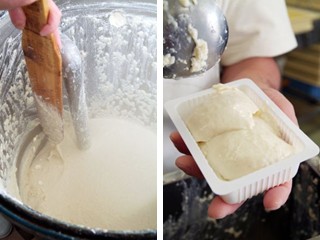
Work begins at 4 am for Omomo. Soybeans that were rinsed the day before and soaked in water overnight are put through a grinder, then boiled in a pressure cooker. Most tofu makers use silicone and other antifoam agents to prevent the foam that arises when boiling beans, but Omomo does not use chemicals. "Thanks to the water softener I rented recently, I don't get much foam," he says. Unlike typical tofu makers, who rarely touch the pressure cooker while the beans are boiling, Omomo frequently opens the cooker and stirs the contents well with a wooden implement called kai. "A bit too thick," he might mutter, and add water.
Local varieties of soy, while sweet and rich in fragrance, have highly diverse characteristics. Making good artisan tofu takes fine-tuning to fully draw out the unique flavor of the beans. This is not possible with mass manufacturers that use belt conveyors. The "slow" style of tofu production, in which the maker pays heed to the individual characteristics of the beans, is what distinguishes the taste of these small-shop tofu from their mass-produced counterparts.
Omomo observes that while about 960 tofu shops now remain in Tokyo alone, they are closing down at a rate of 4 to 5 a month. His hope is that local tofu shops will survive by differentiating themselves through the use of unique soybeans. Inspired by Toziba's activities, Omomo borrowed a not-very-arable plot two years ago with Yamaguchi and fellow tofu makers, including Kurosawa Dofu, from an organic farm in Ibaraki Prefecture. There, together with customers, they began growing their own soy and making miso.
"I got into using domestic soy, and local varieties, purely because I wanted to make good tofu," notes Omomo. "But since I started going to the farm, I've come to feel more strongly the importance of using domestic beans."
Each of these activities may be of little consequence, but the circle is steadily expanding, influencing and inspiring one another and linking more urban and rural people through the medium of soybeans.
Photo: Hiroaki Horiguchi
